How Baseball Pitchers Can Safely Use The Bench Press To Throw Harder Immediately.
In this special report I’m going to share with you some very valuable information that you wouldn’t ordinarily get your hands on.
Regarding the bench press maneuver, there are three camps of people out there.
- People who believe in using the bench press for baseball pitchers
- People who DO NOT believe in using the bench press for baseball pitchers
- People that aren’t sure - this is a completely new dilemma to them
Which camp are you in?
Let me educate you on camp #2, the Non-Believers…as I use to be one of these, but I’m a converter into camp #1 because of scientific evidence.
Non-believers have many reasons why ball players...specifically pitchers should not bench press. They are (and I’m sure more have been created that I don’t know about):
Issue #1: The only reason you would ever bench press is to gain size, and look good.
Dr’s. Rebuttal: It’s not the exercise that gets you big, it’s the prescription in the exercise; your reps, sets, and amount of time under tension. The size of your muscle can be grown with any exercise if performed in a specific way. Your goal with training for baseball is NOT to gain size, rather it’s to gain massive strength, power and speed.
Issue #2: You are locked into internal rotation, and this is bad for throwers because it impinges on the rotator cuff and bicep tendon.
Dr’s. Rebuttal: This is an easy one that I’ll show you with a few pictures. You are not locked into internal rotation. As a matter of fact you are never really in an internally rotated position. See the pictures below.
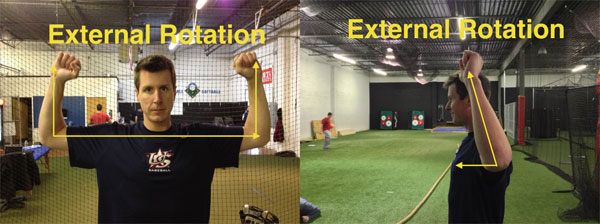
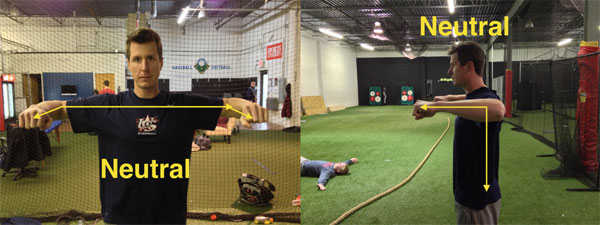
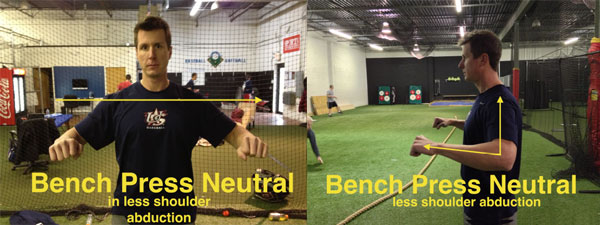
With an overhand grip, the shoulder does move into slight internal rotation at the TOP of the press where less strain is placed on the shoulder. In my opinion, there is not enough internal rotation occurring to place the joint at risk. This internal rotation of the shoulder does not occur at the bottom of the press where more stress in placed on the anterior/front shoulder structures (see picture below).
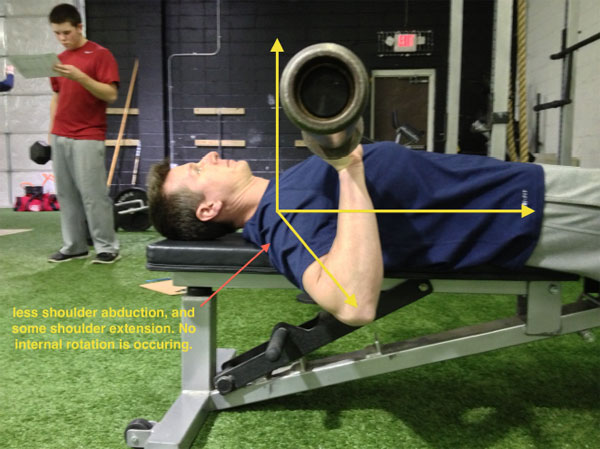
Both believers and non-believers are concerned with impinging the rotator cuff. When performed correctly, the bench press is not an exercise that will impinge the rotator cuff or the biceps tendon. If this doesn’t settle your mind about performing a bench press with a traditional bar, you can use a neutral grip bar or Swiss bar instead, pictured below.

Issue #3: Because your shoulder blades are locked back, abnormal stresses are placed on the shoulder (ball and socket) joint.
Dr’s. Rebuttal: Your shoulder blades are never locked and are always free to move. The scapula (shoulder blade) is placed between layers of fascia (pronounced: fa-sha) and muscle, and it slips and slides between them no matter how much weight is on your chest. Some people who teach bench press will tell you to “lock” your shoulder blades down and back as this creates greater stability at the shoulder. Well for starters, you cannot maintain this position of the scapula because it defies the science of how the body moves (kinesiology). The chest muscles are the prime movers (or agonists) during the bench press. When a prime mover contracts, it’s opposing muscle groups (the antagonists) relax in order to allow that movement to occur. So the exact muscles you are supposedly contracting to pull the scapula down and back (the middle trapezius, rhomboids, lower trapezius) are actually relaxing to allow the press, during the bench-pressing movement, to take place. I have no evidence to prove this, but perhaps trying to firmly contract your scapulas stabilizers while at the same time performing a pushing movement will alter your movement pattern or decrease your neuromuscular control. Current evidence has proven that decreased neuromuscular control at all human joints is a risk factor for injury, and is a huge part of injury rehabilitation.
Now, no muscle is ever 100% relaxed, as we all have a degree of resting tone in our muscles that helps to give its shape. I will say that your antagonist muscles are likely contracting some to help give stability to the shoulder complex. Imagine trying to get up on a floating raft in a pool- it would be much easier if someone were holding the raft to prevent it from moving.
So we know that your shoulder blades are freely moving despite your best attempts to keep them in one spot if that’s how you were taught. Next, is the abnormal stress part, which actually brings us to issue #4.
Issue #4: There is too much stress placed on the anterior/front structures of the shoulder, and it stretches them out making the shoulder less stable.
Dr’s. Rebuttal: Lets define “abnormal stress:” Pressure or tension exerted on a material object that is beyond the normal.
As a baseball pitcher, you have a great amount of external rotation and extension range of motion (also termed horizontal abduction) on your throwing shoulder. Specifically, you have up to 30 degrees.1 This range of motion is normal for you, and every other overhead athlete for this matter, as this helps you to greater separate your hips from your shoulders to create a whip like effect for fast and hard
throwing. Most people think that because you have a lot of movement (hypermobility) here, you are unstable; and that because the bottom of the bench press movement brings you into this range, you are further stretching out important structures and this can lead to instability.
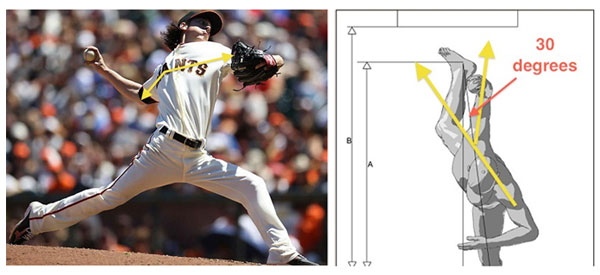
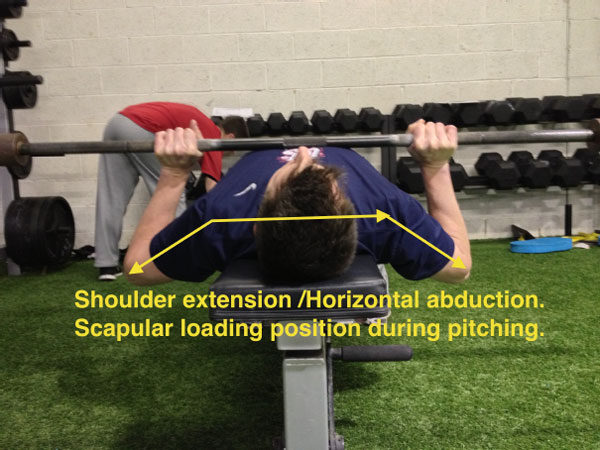
Back up a few sentences…” this range of motion is normal for you…” You are not stretching out anything, but merely working within the range of motion you already have. If you are experiencing symptoms of instability, your posterior rotator cuff is likely weak (instability symptoms also mimic other shoulder conditions…check with your local board certified physical therapist). Plus, if you’re successful in pulling your shoulder blades down and back, you’re actually creating a better position for the humeral head to sit behind the plane of your body, and with even less stress!
The old way of thinking was that if you dislocated your shoulder out the front, you needed to build up your pectorals and muscles on the front of the shoulder, like the subscapularis to “block” it from popping out again. Through evidence we have learned that strength training these muscles pulls the humeral head (the ball) closer to the front of the shoulder, towards an anterior dislocation.2 Nowadays, research studies have shown us that the posterior rotator cuff is responsible for keeping the ball in the socket.2,3 The stronger those muscles are, the less likely you’ll feel unstable.
Back to the matter at hand; bringing the bar down to your chest is completely normal and you are safe to do so as a baseball pitcher. If my reinforcement still doesn’t ease your nerves about doing this, place two baseball gloves (or a thick towel roll) on your chest and let the bar gently touch this instead.
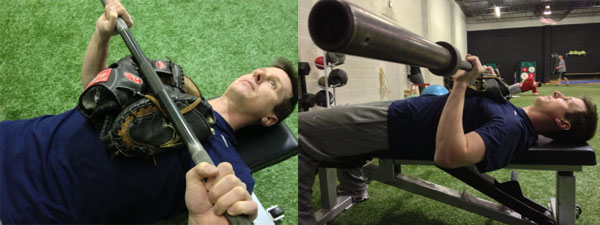
In my opinion it’s crucial to train for power in these lower ranges of motion (when the bar is closest to the chest) since that is where most of your upper body power is created from during a throwing motion.
Non-believers will stray away from bench press and have their athletes do push-up variations instead. Push-ups also take the shoulder near the end ranges of motion. See the picture below.
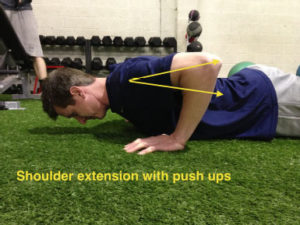
Issue #5: By performing the bench press, all that anterior/front of shoulder stretching is going to disrupt normal proprioception or joint position sense, making it harder to have touch and finesse for off-speed pitches.
Dr’s. Rebuttal: Knowledge was just given to you in the last paragraph, and you are now aware that excessive stretching does NOT take place on the front of the shoulder. Therefore, the tiny little nerve endings called proprioceptors, that help tell you where your arm is in space (if we close our eyes) do NOT get stretched out and remain safe. Even if they were to get stretched - they move around, and remodel within your tissue with proper exercise, and help you determine your joint position awareness. You will absolutely have no problems with producing the right touch and finesse for off-speed pitches if you bench press.
Issue #6: Open chain exercises (exercises when the furthest end of your body part moving the weight is free) like the bench press motion are included later in rehab, and closed chain exercises like the push up are included early rehab because they are less stressful to the shoulder joint.
Dr’s. Rebuttal: This is just false. You choose: get into a push up position, on your knees even, and do a push up. Now lie on your back with your arm straight up in the air, bring it down then punch up again. Which one felt harder to do?
Why would exercises where you load even just partial body weight on your shoulder be less stressful than an exercise where you have significantly less weight attached to it? It’s not! So don’t believe it. Here is my protocol I use as a guide to rehab baseball players with SLAP repairs. In it, you will clearly see that closed chain exercises come much later in the rehab after open chain movements - about 8 weeks after surgery.
Issue #7: Dumbbell workouts for your chest are just as effective for gaining strength of the chest and triceps. Using dumbbells are also less stressful on the shoulder because they allow freedom of movement of the shoulders, elbows and shoulder blades.
Dr’s. Rebuttal: Dumbbells do offer you a greater freedom of motion (with weights below 80lbs), thereby requiring greater stability be present at the shoulder joint. Some say this increases muscular activity of the muscles that control the shoulder blades. While this hasn’t been proven yet, and may not until someone creates a bench with a hole in it (so it won’t compress the electrodes and cause altered readings), this is likely true. It also probably activates the bicep more, and any other muscle that crosses the shoulder joint to enhance its stability.
That’s all fine and dandy. You can include dumbbell work in your workout to help create stability at the shoulder joint. However, you will not be able to create the kind of upper body power with dumbbells that you can with the bench press. Power equals speed/greater velocity. You can’t have one without the other, and you can’t train for one without the other. Training with dumbbells and push up variations with bands isn’t going to get the job done in terms of power and speed; and your throwing shoulder needs to be powerful to become a high velocity pitcher.
Issue #8: There is no evidence that shows the bench press translates into faster throwing speeds.
Dr’s. Rebuttal: There is plenty of evidence. A study by Newton and McEvoy4 showed that high school and college baseball players without weight training experience, who performed the bench press movement, significantly increased their throwing velocity by 4.1% over 8 weeks, compared to those who only performed chest plyometrics. (ie - If you throw 80mph, your velocity gain would be between 3-4mph) The subjects were even using a poor power training prescription of 3 sets of 6-10 reps; this will surely increase muscle hypertrophy, NOT maximally improve power AND is likely the reason why velocity gain was so low.
I’ll explain the proper exercise prescription for the bench press to increase velocity, speed and power in the next section.
An important concept to remember when your trying to increase speed and power on any part of the body: If you go to a “speed school” and you are working on just agility drills, plyometrics, and sprints…and not power gym exercises like the bench press (for upper body speed) and deadlifting or olympic lifts (for lower body speed), you are only reaching 50% of your potential, and wasting 100% of your money.
Two more studies5,6 report the effectiveness of the bench press in significantly improving throwing velocity in male and female elite handball players. The throwing motion for handball is exactly the same as baseball. The mass of an elite handball (16.8oz) is approximately 3x the mass of a regulation baseball (5oz). More power/torque must be produced to move the handball faster. The baseball is lighter; therefore less power is needed in comparison to moving the handball. However it makes no sense to train your body to produce less power, as having less power equals less speed and acceleration creation. The more power potential you have, the more you can use it to your advantage.
Issue #9: Bench pressing is an injury producing movement.
Dr’s Rebuttal: In the literature that I have searched, there have been no studies that have proven a cause and effect relationship between the bench press movement and injury risk. In a study of 10,908 college football players over 4 years, weight room injuries to the shoulder occurred less than 5 total times in approximately 300,000 workouts in the gym.7 For you that means a shoulder injury/soreness can occur due to weightlifting every 1000 times that you weightlift. It was not said what exercises were performed but we must assume that the bench press (in addition to other upper body lifts like certain Olympic lifts, and shoulder press) was implemented, as it’s an integral part of most football strength training programs.
There are studies that show positions that place less strain on the shoulder during the bench press. Gasping the bar slightly wider than shoulder width as seen in the picture below, places less strain on the anterior capsule, anterior and posterior rotator cuff, as well as the biceps tendon.8,9,10,11 When you bench press, make sure you grab the bar in this manner. Grabbing the bar wider puts more strain on the aforementioned structures, but also takes strain off the posterior labrum and posterior capsule.12,13 If you’ve had an injury to the posterior labrum or joint capsule, take a grip slightly wider than the one pictured below.
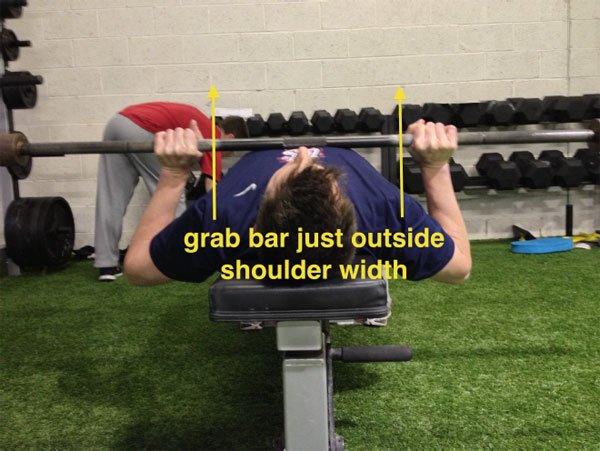
In conclusion:
The bench press movement is a safe technique that can induce great strength and power gains which will translate into faster throwing speeds. Performing the bench press will move you that much closer to becoming a high velocity pitcher. During the bench press you are never locked into shoulder internal rotation and your scapulae are freely moving. Range of motion and strain on the front or anterior shoulder is not excessive during the bench press and this will never lead to a reduced ability to pitch with finesse. There is no current evidence that shows bench press leads to injury greater than any other area of the body; in fact it may even be significantly less.
How to perform the bench press movement:
If you are new to bench pressing, take your time in learning the movement patterns first, then begin to increase the weight. First, lay back on the bench and grab the bar directly over your shoulders, then slide your hands outward about the length of your hand. Have a spotter help you lift the bar off the rack. Once stabilized in the top position, lower the bar down to your chest—gently tapping your chest at about your nipple line. There is no need to pinch your shoulder blades back and down unless you feel more comfortable doing so. While lowering the bar, some strength trainers may have you try to bend the bar, as if you were going to create an upside down “U” with the bar. Again, play around with this if you choose to, and use it if it feels good to you. Press the bar back up to the starting position. The arc of motion with which you push will be slightly different with every rep you take. In general, just push the weight straight up, and don’t worry about arcing the bar in any special way. Again, some trainers will advocate that on the press up, you should put force through the bar as if you were trying to slide your hands apart further, or try to lengthen the bar. I’m not huge on this, but again, try it and if you really like it, stick with it. Try not to over complicate this exercise. It’s a simple pushing movement. Bar comes down, bar goes up.
Your sets and rep count:
This will vary by the strength specialist, but keeping with the evidence-based theme the best way to create upper body power with the bench press is to train in a power rep range. Therefore, you prescription will look like this:
Warm up with an active warm up and dynamic stretching routine for the upper body.
2 sets total
- (1st set) 3 reps at 95% of your 1 rep maximum
- Immediately after this, perform a brief chest plyometric activity—like 6 clapping push-ups.
- Take 5 minutes rest (sit down and don’t do anything)
- (2nd set) 5 reps at 85% of your 1 rep maximum
- Repeat brief plyometric activity
- Rest 5 minutes again.
- Bench Press Done.
**I never want you to 1 rep max out on the bench press.
How to find your 1 rep maximum without actually lifting 1 rep:
Find your 5 rep maximum. Start with a challenging weight that you know you’re capable of lifting 5 times. Rest exactly 1 minute and add weight to the bar during your rest period. Lift this new weight for 5 more reps. Repeat rest and lift cycles until you can no longer lift 5 reps. You might only have to add weight 2x. If you lift a weight up 4 times, but not 5 - your prior 5 rep lift will be your 5 rep maximum. Take this 5 rep maximum and multiply it by 1.2. This is an estimate of your 1 rep maximum. It is crucial to rest only 1 minute in between attempts, as if you rest longer, you will recover more and your 1 rep maximum estimate will be higher making your training loads impossible. Multiply your 1 rep max estimate by .95 and
.85 for 95% and 85%, respectively.
About the Author:
Dr. Chris McKenzie is a board certified sports and orthopedic physical therapist, expert strength trainer, and adjunct professor at Drexel University in Philadelphia. Being a sports physical therapist, Dr. McKenzie has physically examined hundreds of baseball players and pitchers for both injury rehab, and performance optimization purposes, at the high school through professional levels. You can contact him at http://maximumsportperformance.com
References:
- Fleisig GS, Barrentine SW, Zheng N, et al. Kinematic and kinetic comparison of baseball pitching amoing various levels of development. J of Biomechanics. 1999; 32: 1371-1375
- Cain PR, Mutschler TA, Fu F, et al. Anterior stability of the gleno-humeral joint; a dynamic model. Am J Sports Med. 1987; 15: 144-148
- Davies G, Ellenbecker TS, Focused exercise aids shoulder hypomobility. Biomechanics. 1999; 6: 77-81
- Newton RU, McEvoy KP. Baseball throwing velocity: a comparison of medicine ball training and weight training. J Strength Cond Res. 1994; 8: 198-203.
- Marques MC, van den Tilaar R, Vescovi JD, Gonzalez-Badillo JJ. Relationship between throwing velocity, muscle power, and bar velocity during bench press in elite handball players. Int J Sports Physiol Perform. 2007; 2(4):414-22.
- Hoff J, Almasbakk B. The effects of maximum strength training on throwing velocity and muscle strength in female team-handball players. J Strength Cond Res 1995; 9(4) 225
- Zemper ED. Four year study of weightroom injuries in a national sample of college football teams. Nat Strength and Cond Assn Jour. 1990; 12(3): 32-34
- Harman E: A 3D biomechanical analysis of bench press exercise [abstract]. Med Sci Sports Exerc. 1984 16: 159-160
- Thompson WO, Debski RE, Boardman ND III, et al: A biomedical analysis of rotator cuff deficiency in a cadaveric model. Am J Sports Med. 1996; 24: 286-292
- Wilk KE, Arrigo CE, Andrews JR: Current concepts: The stabilizing structures of the glenohumeral joint. J Orthop Sports Phys Ther. 1997; 25: 364-379
- Green CM, Comfort P. The affect of grip width on bench press performance and risk of injury. Strength and Cond Journ. 2007; 29(5): 10-14
- Hawkins RJ, Janda DH: Posterior instability of the glenohumeral joint. A technique of repair. Am J Sports Med. 1996 24: 275-278
- Soslowsky LJ, Flatow EL, Bigliani LU, et al: Quantitation of in situ contact areas at the glenohumeral joint: A biomechanical study. J Orthop Res. 1992 10: 524-534,


In my experience most athletes won’t be able to do 3 reps in the bench press with 95% of their 1 rep max.
It is definitely tough, and something to shoot for. Most would have an easier time starting at either 90% or as low as 85% for the 3 reps AND 5 reps. After about 2 weeks they should have the strength to lift 95% at 3 reps, but if not just keep shooting for it 🙂 Lifting in the 85-100% of max range is critical to gaining strength and power with minimal mass gain.
Use a spotter!